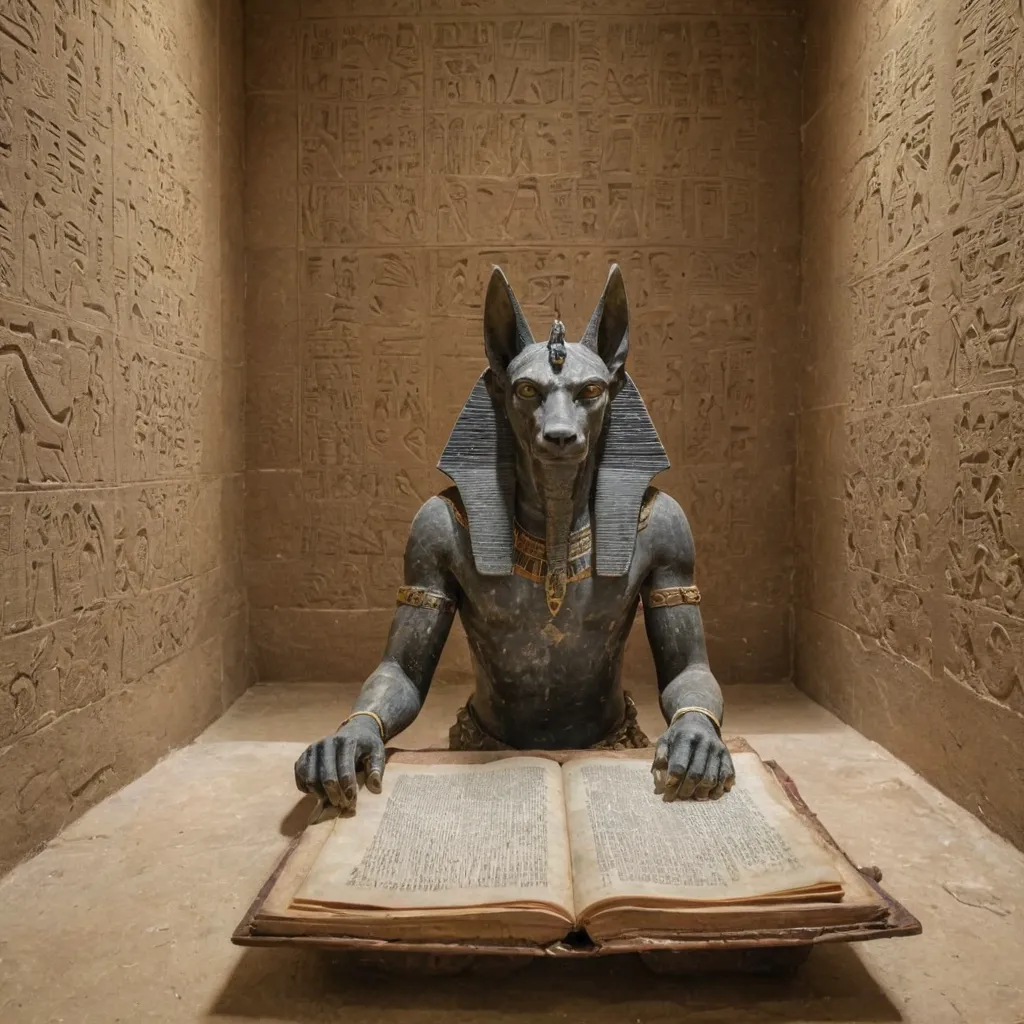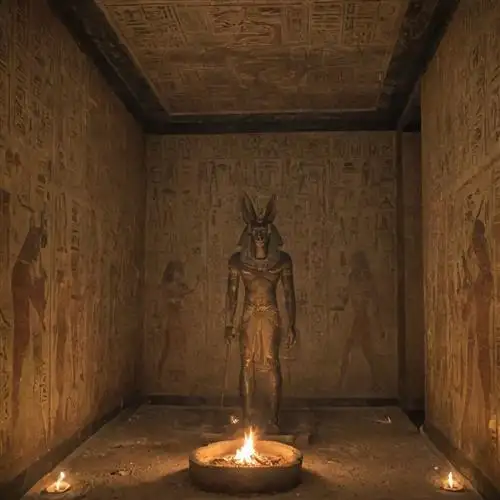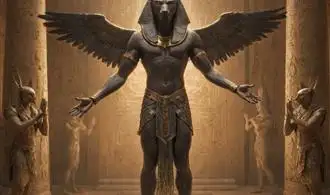
Unveiling the Mysteries of Anubis
Anubis, the enigmatic jackal-headed deity of ancient Egyptian mythology, has long captivated the imagination of scholars, spiritualists, and seekers of the esoteric. As the god of the dead, embalming, and the afterlife, Anubis' role in the Egyptian pantheon was integral to the beliefs and rituals surrounding death and the journey into the next realm. To truly understand the power and significance of Anubis, we must delve into the intricate symbolism and profound concepts that he represents.
At the core of Anubis' dominion lies the concept of transition and transformation. As the guardian of the necropolis and the protector of the deceased, Anubis presided over the crucial rite of mummification, ensuring the preservation of the physical form and the safe passage of the soul into the afterlife. This pivotal role imbued Anubis with the power to guide the dead through the treacherous and uncertain journey of the underworld, offering protection and facilitation along the way.
Beyond his association with the dead, Anubis was also revered as a deity of healing and regeneration. His keen senses and intuitive nature were believed to grant him the ability to detect and diagnose ailments, making him a trusted figure in the ancient Egyptian medical traditions. Furthermore, Anubis' connection to the cycles of nature and the rhythms of the earth reinforced his role as a deity of rebirth and transformation, offering hope and the promise of renewal to those who sought his guidance.
To invoke the blessings of Anubis, practitioners often engage in rituals that honor his multifaceted nature and tap into the potent energies he represents. These rituals may involve the use of symbolic objects, such as the jackal-headed amulets or the depiction of Anubis in sacred art, as well as the recitation of invocations and the performance of specific gestures or movements. By aligning themselves with the principles of transition, transformation, and the mysteries of the afterlife, devotees seek to harness the protective and regenerative powers of Anubis, fostering a deeper connection to the cyclical nature of existence.
Rites of Passage Guided by Anubis
In the ancient Egyptian pantheon, Anubis stands as a revered deity whose influence extends far beyond the realms of the dead. As the god of embalming and the afterlife, Anubis is deeply intertwined with the rites of passage that mark the journey from this world to the next. For those seeking to invoke the blessings of this powerful deity, a profound understanding of the Rites of Passage guided by Anubis is essential.
Anubis is the guardian of the necropolis, the sacred city of the dead, and his presence is most keenly felt during the crucial moments of death and the subsequent preparations for the afterlife. The mummification process, a sacred ritual overseen by Anubis, is a crucial step in ensuring the deceased's successful transition to the afterworld. This intricate procedure, which involves the removal of internal organs, the preservation of the body, and the wrapping in linen, is a testament to Anubis's role as the patron of the dead.
Beyond the physical aspects of the mummification rite, Anubis also presides over the spiritual and ritual components. The weighing of the heart ceremony, where the deceased's heart is weighed against the feather of truth, is a pivotal moment guided by Anubis. This ritual, known as the "Judgment of the Dead," determines the fate of the soul, ensuring that only the righteous may pass into the afterlife. Anubis, as the guardian of this sacred process, ensures the fair and impartial judgment of the deceased, granting them the opportunity to join the ranks of the eternal.
The journey of the soul after death is also deeply intertwined with the presence of Anubis. As the guide to the underworld, Anubis is responsible for escorting the deceased through the treacherous realms of the afterlife, navigating the various challenges and obstacles that stand in the way of the soul's ultimate destination. The deity's unwavering protection and guidance are essential for the successful completion of this perilous journey, ensuring the deceased's safe passage to the realm of the gods.
For those seeking to invoke the blessings of Anubis, the incorporation of specific rituals and practices can be profoundly transformative. These rites, rooted in ancient Egyptian traditions, are designed to align the individual with the energy and wisdom of the deity, granting them protection, guidance, and the opportunity to deepen their connection with the divine.
Offerings and Invocations to Anubis
Offerings and Invocations to Anubis are a crucial aspect of honoring the ancient Egyptian god of the underworld, embalming, and the dead. Anubis, the jackal-headed deity, holds immense power and significance in the Egyptian pantheon. To invoke the blessings of Anubis, certain offerings and invocations must be performed with reverence and intention.
One of the most important offerings to Anubis is the presentation of natron, a salt used in the mummification process. Natron is believed to symbolize the purification and preservation of the deceased, which aligns with Anubis's role as the guardian of the dead. Placing natron on the altar or within the ritual space can help to create a sacred atmosphere and connect the practitioner with Anubis's energy.
Another powerful offering to Anubis is the burning of incense, particularly frankincense and myrrh. These fragrant resins are believed to help facilitate communication with the divine and create a sense of reverence within the ritual space. The aroma of the burning incense can also help to invoke Anubis's presence and aid in the attunement of the practitioner's senses.
In addition to physical offerings, invocations and prayers to Anubis are an essential part of the ritual process. Reciting specific invocations, such as "Hail, Anubis, Lord of the Dead, Guide of Souls, Protector of the Necropolis," can help to establish a connection with the deity and invite their blessings and assistance. These invocations can be repeated during the ritual, or the practitioner can create their own personal prayers and offerings to Anubis.
It is also important to consider the timing of the rituals and invocations to Anubis. The Egyptian god is often associated with the night, the dark, and the liminal spaces between life and death. Performing rituals during the night, or during the new moon, can be particularly powerful and align with Anubis's energies. The practitioner may also choose to work with the cycles of the moon or the annual cycles of the Nile to further honor Anubis and enhance the effectiveness of the rituals.
Communing with Anubis in the Afterlife
Anubis, the jackal-headed Egyptian god, is revered as the guardian of the dead and the keeper of the underworld. For those seeking to commune with Anubis in the afterlife, several powerful rituals can be employed to invoke his blessings and guidance. These rituals are not only deeply spiritual but also provide a means to connect with the ancient wisdom and mysteries surrounding this enigmatic deity.
One of the most profound ways to commune with Anubis is through the practice of dreamwork. By engaging in focused meditation and visualization, individuals can seek audience with Anubis in the dreamscape. During these encounters, Anubis may impart valuable insights, offer guidance, or even reveal the secrets of the afterlife. It is crucial to approach these dreamtime interactions with reverence and an open mind, as Anubis is known to be both benevolent and intimidating in his dealings with the living.
Another powerful ritual involves the creation of an Anubis-focused shrine or altar. By carefully curating the elements, symbols, and offerings associated with Anubis, devotees can establish a sacred space for communication and veneration. This ritual may include the use of black candles, images or statues of Anubis, and offerings such as myrrh, black salt, or black feathers. Through focused meditation and prayer, individuals can invoke the presence of Anubis and seek his blessings or guidance.
For those seeking a more direct connection with Anubis, the ritual of mummification can be a powerful and transformative experience. By undergoing a symbolic death and rebirth, individuals can align themselves with the journey of the soul through the underworld. This ritual often involves elaborate preparations, including the purification of the body, the application of sacred oils, and the wrapping of the body in linen. Through this process, the devotee can experience a deeper understanding of the mysteries of death and the afterlife, and potentially receive the blessings and protection of Anubis.
Exploring the Symbolism of Anubis
Anubis, the jackal-headed deity of ancient Egyptian mythology, is a figure steeped in profound symbolism and reverence. As the god of embalming and the afterlife, Anubis played a crucial role in guiding the souls of the deceased through the perilous journey to the realm of the dead. His presence was deeply intertwined with the rituals and beliefs surrounding death and the transition to the afterlife.
At the heart of Anubis' symbolism lies his association with the mummification process. As the patron of embalmers and the protector of the dead, Anubis oversaw the meticulous preparation of the deceased, ensuring their bodies were preserved and ready for the journey to the afterlife. This sacred duty was of utmost importance, as the ancient Egyptians believed that the physical form was intrinsically linked to the soul's ability to continue its existence in the afterlife.
Beyond his role in mummification, Anubis was also revered as the guardian of cemeteries and the keeper of the scales of judgment. In the final stage of the deceased's journey, Anubis would weigh the heart of the individual against the feather of Ma'at, the goddess of truth and justice. This pivotal moment, known as the "Weighing of the Heart," determined whether the soul would be granted eternal life or condemned to oblivion. Anubis and the Afterlife - I Did It and So Can You delves deeper into this crucial aspect of Anubis' role in the afterlife.
The jackal-headed figure of Anubis also holds profound symbolic meaning. The jackal, a scavenger known to roam the edges of the desert, was believed to be the intermediary between the world of the living and the realm of the dead. This connection to the liminal spaces between life and death further solidified Anubis' role as the guide and protector of the deceased.
Interestingly, the color black, which was associated with Anubis, also held deep significance in ancient Egyptian beliefs. Black was the color of the fertile soil of the Nile River, symbolizing regeneration, rebirth, and the cyclical nature of life and death. This association with the color black further reinforced Anubis' role as the god of the afterlife and the guardian of the transformation from earthly existence to eternal life.
















